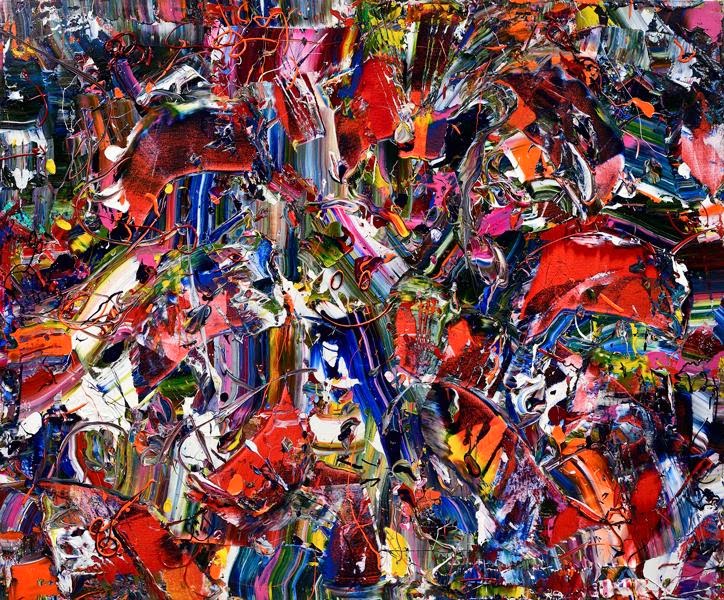Chelsea is comprised of hundreds of galleries. There are three, however, that consistently curate wonderfully rich exhibitions. They truly transform their white washed walls time and time again, showcasing cutting edge artwork that never fails to disappoint the spectator.
I am referring to Ameringer McEnery Yohe, Matthew Marks and Gagosian.
Some time ago, I took five families to these three galleries, and want to take a moment now to reflect on the experience. At each, we saw solo exhibitions - meaning, a show consisting of only one artist’s work - that featured three tremendously different styles.
At Ameringer McEnery Yohe we looked at the paintings and sculptures of Michael Reafsnyder (b. 1969). This artist impressed me for his bold and original techniques of painting without using actual paint brushes. I quote the artist: “I don’t like cleaning brushes…I use anything but a brush.”
To paint, Reafsnyder turns to pallet knives and sometimes found objects, and amazingly, he is able to keep the colors from mixing or turning into a muddled brown hue.
Regarding his work, Reafsnyder states: "The liquidity of paint and clay allow for 'Indiana Jones'-type adventures, a sort of immediate experience in which every turn or twist presents a new pleasure and a new concern. The trick is to make sure that the works do not end up solely as a record of those decisions, but take on a new life."
Perhaps, I suggested to the tour, Reafsnyder embodies a modern-day Jackson Pollock. I referenced several of Pollock’s works so they could visually understand my comparison and gave them a summary of the life of Jackson Pollock. I think I convinced them.
Reafsnyder, like
many artists, has a trademark, a signature that lets people know what is his. It
is not his name, but rather takes the form of a smiley face. He adds the smiley faces to all of his pieces.
It takes a moment to find them, but they are always front and center, and add a
sense of whimsy to his paintings. It is certainly something I have never seen
done before.
The exhibition
also included sculptures by the artist. Reafsnyder constructed them by hand of clay,
engobe (clay slip), glaze and his signature smiley face.
This is a good
time for me to point something out. I have two goals for each of my tours. One
is to teach people about what they are seeing physically in front of them. The
other is to draw comparisons between works of art that someone without an art
history background might not know to make.
I shared with
the group that in my opinion, Reafsnyder’s sculptures are not dissimilar to the
machine constructed sculptures of American artist Roxy Paine (b. 1966). Paine has said,
"I’m interested in taking entities that are organic and outside of the
industrial realm, feeding them into an industrial system, and seeing what
results from that force-feeding. The end results are a seamless containment of
these opposites.” Whereas Reafsnyder’s sculptures were created by hand, Paine’s are
manufactured by machines that the artist has built. His hand, therefore, is
removed, but still factors into the equation.
A few doors down at Matthew Marks, we
saw a solo show of Darren Almond, an English artist, which was his sixth
one-person exhibition at the gallery since 2000. The show included16
photographs made between 2002 and 2012 on all seven continents as part of the
artist’s Fullmoon series - photographs made at night, with exposures lasting
between 15 and 60 minutes. This exhibition was the first time that Almond’s
images from all of the continents were on view simultaneously. Our
discussion focused on three works in the show, all of which I related to Asian
art, in the form of Chinese painted hand scrolls, and Japanese woodblock prints.
Lastly at Gagosian, our
third and final gallery, we saw a solo-exhibition of the paintings of Helen
Frankenthaler, recognized
to be one of the greatest American artists of the twentieth century. In
her words, “the only rule is that there are no rules. Anything is possible. ...
It’s all about risks, deliberate risks.” The exhibition included 30 paintings,
from what was known as her mature style, the period between 1950 – 1959. It is
known that Frankenthaler took inspiration from various sources: landscapes, figures, paleolithic
cave paintings, mythical scenes and childhood memories. I focused on several
paintings that clearly showcased one or more of these influences. For instance,
we spoke about a piece titled Eden, 1956 and showed the group a cave painting from the
Midi-Pyrénées region
in France which contained similar imagery. Similarly,
in Mother Goose Melody, 1959 I saw clear references to Picasso’s cubism and showed the group a work titled
Girl before a Mirror.
The day terminated with a walk down the High Line,
a must-do when I’m in Chelsea on a clear day.
Reafsnyder
Pollock
Gallery shot
Almond
Chinese landscape comparison
Frankenthaler
Cave painting








No comments:
Post a Comment